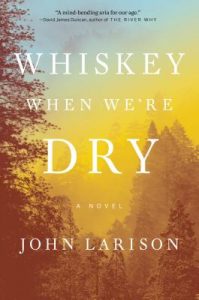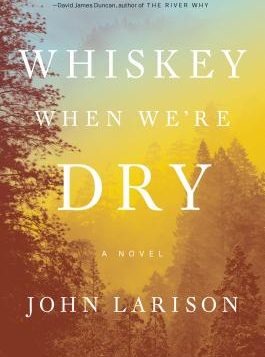 Whiskey When We’re Dry
Whiskey When We’re Dry
by John Larison
Viking. 400 pages, $28.
SET in the years following the Civil War in an unnamed state, Whiskey When We’re Dry is a Western that begins with Jessilyn Harney recalling that her mother died when giving birth to her, leaving her father to raise her and her brother Noah, who was five years old at the time. The father is portrayed as a good man, but, like so many men of this genre, a man of few words, stoic, and hard-bitten. His son, on the other hand, seems gallant at birth, taking care of Jessilyn when their father drinks too much. Indeed Noah is a conscientious brother, making sure that his sister is warm, dressed, fed, and protected—until she’s thirteen, at which time Noah has a fistfight with their father (it happens a lot in Westerns) and rides away.
For the next few years, Jessilyn does what she can to help her father run the ranch, but he’d hit his head on a rock in the fight with Noah and is never quite the same. Sensing the reality of his own decline, he helps hone her natural sharpshooting ability for her protection, and he talks of marrying her off. Months later, he is found by his daughter, having died six days before. Still barely in her teens and finding herself adrift, Jessilyn reaches out to a neighbor, a Mormon woman who had been enlisted by the father to teach Jessilyn at least a minimum of feminine wisdom. But the Mormon family refuses to take her in, and that’s when Jessilyn decides to open the old wooden box that Noah had left behind, where she finds some of his outgrown clothes—things that fit her fine—and she becomes Jesse.
If this transition sounds slightly hackneyed, the author avoids cliché by adding numerous details to the narrative and by fleshing out the characters who populate his tale. We learn, for example, of the neighborliness mixed with sheer ruthlessness of the Mormon family. We’re reminded in a vivid incident of men’s attitudes toward women in this male-dominated culture. We also get a sweeping picture of the beautiful brutality of the land.
The author does not belabor Jessilyn’s lack of femininity, her reluctance to marry, or the already well-established perception of her unattractiveness as factors that make it easy for her to dress in her brother’s clothes. Larison leaves little doubt that there are few mercies or kindnesses in store for the main character, either from other human beings or from the natural world.
The focus of Jesse’s adventure isn’t acquiring wealth or gun-slinging fame; it is entirely a quest to find his brother. He learns of a militia run by a ruthless, corrupt official who’s focused on the “dead” part of the “dead or alive” notice for Noah’s capture, and he skillfully wangles his way onto the force. This becomes the turning point in the story: rather than strictly a Western adventure, it becomes a tale of male-bonding, a gauzy lesbian romance, and a politically incorrect bit of fictional history. Along the way, Larison offers readers gifts in the form of a series of small plot surprises that make the same old story into something that feels updated and special, despite its setting of more than a century ago.
________________________________________________________
Terri Schlichenmeyer is a freelance writer based in Wisconsin.






